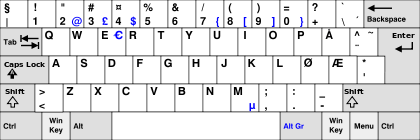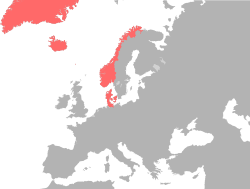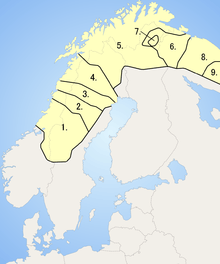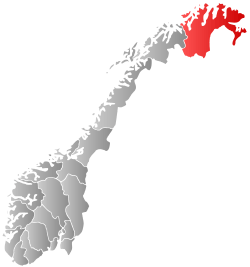Languages of Norway
| Languages of Norway | |
|---|---|
| Official languages | Norwegian (Bokmål and Nynorsk), Sami and Kven |
| Minority languages |
Romani language Swedish language Finnish language Russian language |
| Main foreign languages |
English (>80%) French German Swedish Finnish Russian |
| Sign languages | Norwegian Sign Language |
| Common keyboard layouts |
 |
There are a large number of languages spoken in Norway. Of these, the Norwegian language is the most widely spoken and the main official language of the country.
Norwegian
The most widely spoken language in Norway is Norwegian. It is a North Germanic language, closely related to Swedish and Danish, all linguistic descendants of Old Norse. Norwegian is used by some 95% of the population as a first language. The language has two separate written standards: Nynorsk ("New Norwegian", "New" in the sense of contemporary or modern) and Bokmål ("Book Language/Tongue/Speech"), both of which are official.
Norwegian language struggle

Known as Språkstriden in Norwegian, the Norwegian language struggle is a movement rooted in both Norwegian nationalism and the 400 years of Danish rule in Norway (see Denmark-Norway). The koiné language (mixed language) known as Dano-Norwegian (Dansk-Norsk) which developed in Norwegian cities was the result of Danish replacing Norwegian as the language of the elite in that country (Danish was used in courts of law, by the cultured, and, after the Lutheran Reformation of 1536, replaced Latin as a liturgical language). An adoption of Norwegian orthography into the Danish language gave rise to the written standard of Riksmål, which later became Bokmål. Nynorsk, a new standard of Norwegian based upon the spoken language in rural Norway, was acknowledged by the parliament in 1885, and in 1892 it was first possible to use Nynorsk as a language of primary instruction. By 1920, Nynorsk was being used widely in western Norway and the mountain valleys, where it still has its stronghold, and Bokmål was used in the more populous areas of the country. Later, attempts were made to reconcile the two standards into Samnorsk, or "Common Norwegian", although this never came to fruition.
Bokmål
Bokmål, the written language of 80-90% of the Norwegian population,[1] is based on Riksmål, although it differs in terms of genders, lexicon, counting system, a tendency to permit concrete noun endings in abstract situations and diphthongs versus single vowels. Riksmål was officially changed to Bokmål in 1929.
Nynorsk
Nynorsk was developed by the linguist Ivar Aasen in the 1850s, based on rural, spoken Norwegian, rather than the cultured, Danish-influenced Norwegian spoken in cities. Its first official codification was in 1901, was given the name Nynorsk in 1929, and has been used officially (alongside Bokmål) since 1938. Its usage, however has declined: in 1944 it was used by 34.1% (highest recorded number), in 1971 by 17.5% of the population, today, some 15% of schoolchildren are taught Nynorsk as their written language, and Nynorsk is reportedly used as main form of Norwegian by around 7.4% of the total population, whereas an additional 5% switch between Bokmål and Nynorsk.[1]
Høgnorsk
A more conservative variation of Nynorsk exists, called Høgnorsk. It has few active users, but is supported by the Ivar Aasen-sambandet organization, founded in 1965 in response to the samnorsk policy of the government at the time.
Sami languages

The Sami people were the original inhabitants of Northern Scandinavia,[2][3] and though they mostly adopted Norwegian, Swedish, Finnish, or Russian, due in no small part to official assimilation policies,[4] some still speak Sami languages. Sami languages, like Kven and Finnish, belong to the Uralic language family. The Sami languages spoken in Norway include Lule Sami (spoken by around 500 in Norway), North Sami (spoken by around 15,000 Norwegian Sami), Pite Sami (which is nearly extinct) and South Sami (which has around 300 speakers in Norway). Sami languages are official in seven Norwegian municipalities.
Kven


Spoken by the Kven people, the Kven language is a Finnic language, closely related to Finnish, and spoken by some five to eight thousand people in northeastern Norway, particularly in Tromsø (in the county of Troms) and Finnmark. Mirroring the situation of Meänkieli in Sweden, Kven is sometimes considered to be a dialect of Finnish, and has a large degree of mutual intelligibility with the language.
Romani
The Romani people are a diaspora population originating in India, and today are spread across all of Europe. The Romani language, an Indo-European, Indo-Aryan language (related to other languages spoken in India today), is split into a great number of dialects. Two of these, Tavringer Romani and Vlax Romani, are spoken in Norway, by populations of 6,000 and 500, respectively. Scandoromani is another Romani dialect indigenous to Norway, as well as Sweden. Because of the wandering nature of the Roma people, there is no geographic stronghold of the Romani language in Norway.
Norwegian Traveller
Spoken by the Norwegian Travellers, a gypsy population in Norway which intermarried with Romani and Yeniche (German Traveller) populations, the Norwegian Traveller language, also known as Rodi, is based on Norwegian, but has heavy borrowing from Northern Romani and Rotwelsch. There is no estimate on how many Norwegian Traveller speakers there are in Norway, but it is known that the language is alive.
Foreign languages
Nearly 90% of Norwegians can speak English.[5] The country currently scores in the top 5 of the EF English Proficiency Index.[6]
References
- 1 2 Almenningen, Olaf (1996). "Nynorsk i Noreg i dag" (PDF). Norsk Språkråd.
- ↑ Sammallahti, Pekka, 1990. The Sámi Language: Past and Present. Arctic Languages: An Awakening. The United Nations Educational, Scientific and Cultural Organization (UNESCO). Paris. ISBN 92-3-102661-5
- ↑ Sammallahti, Pekka, 1989. A Linguist Looks at Saami Prehistory. Acta Borealia 2-1989.
- ↑ Minde, Henry. 2005. Assimilation of the Sami - Implementation and Consequences. Gáldu Čála: Journal of Indigenous Peoples Rights No. 3. Kautokeino. ISBN 82-8144-012-0
- ↑ "Norwegian English: a fusion language". OxfordDictionaries.com. March 7, 2014. Retrieved March 11, 2015.
- ↑ "EF ENGLISH PROFICIENCY INDEX". EF Education First. 2014. Retrieved March 11, 2015.
![]() This article incorporates public domain material from the CIA World Factbook document "2006 edition".
This article incorporates public domain material from the CIA World Factbook document "2006 edition".
- The Norwegian Language Struggle
- Ethnologue report for Nynorsk
- Ethnologue report for Bokmål
- Ethnologue report for Kven
- Ethnologue report for Rodi
